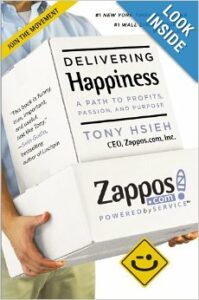 Delivering Happiness: A Path to Profits, Passion, and Purpose
Delivering Happiness: A Path to Profits, Passion, and Purpose
by Tony Hsieh
Business Plus, 2010
The online retailer Zappos is arguably the premiere poster-child for company culture in today’s business world. Zappos started selling shoes online in 1999, which was towards the end of the first dot-com bubble. Not only did Zappos survive the bubble’s burst, They managed to grow from $1.6 million in sales in 2000 to $1 billion in sales in 2008. That’s almost a factor of 1,000 (and two years ahead of their schedule, no less). Selling shoes. Online.
How is that possible? Well it seems culture was a big part of it. There are plenty of business articles and blogs out there that extoll the virtues of the Zappos culture, and CEO Tony Hsieh (pronounced “Shay,” by the way) wrote a book in 2010, titled Delivering Happiness, that tells the Zappos story, in which culture plays a very prominent role. In the book, he explains how and why he put so much of his own time and attention into building the culture at Zappos. By 2009, “Delivering Happiness,” became the brand promise of Zappos and vision and purpose statements were simplified to “Zappos is about delivering happiness to the world.” In the book he actually talks about a few “happiness frameworks” that he pulled from scientific literature.
But here’s what I noticed as I read the book: the Zappos culture isn’t really about happiness. They have ten core values, and happiness isn’t mentioned once among them. I point this out because I think it is critical to de-bunk the myth that links corporate culture and being happy. The myth goes something like this: employee “engagement” happens when you have a “positive” culture where everyone is happy and friendly and “cohesive.” That’s not true. I think we’re confusing the results of a strong culture with the attributes of a strong culture.
In reality, the happiness we notice is a by-product of a corporate culture that engages people around the success of the enterprise and their own development at the same time. Hsieh actually studied the science of happiness and realized that basic pleasure, which we often associate with the feeling of being happy, is really just the first step. Touching people’s passion generated much more happiness, and connecting to a higher purpose raised the bar even more. Hsieh realized that if he could build a business that enabled a smooth flow between the passion and purpose of both customers and employees, he knew he’d be delivering happiness, and he knew he’d be successful.
It turns out that in the case of Zappos, the sweet spot for doing that is customer service. Hsieh figured out early on that if you’re selling shoes online, then delivering what he called the “WOW” through customer service was going to be a primary driver of success of the company. So that is the core of their culture: customer service. In fact, he once described Zappos as a “customer service company that just happens to sell shoes.”
How does that happen at Zappos? Well, they do things differently than other online retailers, like letting their customer service reps in the call center spend as long as they want talking to the customers (the record is over 10 hours for one call). The call center employees needed the decision making power in order to deliver the WOW, so Hsieh gave it to them. He also realized he needed to let them truly be themselves, be adventurous, embrace change, and learn how to do more with less, so he changed the way things were done at Zappos so his people could do those things. These are some of Zappos’ core values (be yourself, embrace change, do more with less). Those values are focused squarely on enabling amazing customer service. It turns out when your culture drives success, the happiness is just the result.
Hsieh believes that the alignment between the organization and the core values is so powerful, he argues that to some extent it doesn’t matter what values you choose. If you do the alignment right, you’ll see the results. I am not convinced. When I look at the values Zappos chose, I see a lot of overlap with Humanize. Decentralization, ownership, transparency, personal development. I think Hsieh does have a point about the straight-up power of aligning the organization and values, but perhaps he’s undervaluing the power of choosing values that tap into what makes us human.
I read this book in one afternoon. It is both that readable and that short! But it’s worth it. Tony writes the book as if he were speaking, so you get to hear what the CEO actually thinks. I know you’re thinking to yourself, “Yeah, but I’m not Zappos, so I can’t do that,” but please read the book anyway. Because you can do that.
